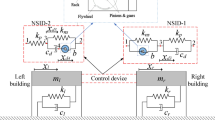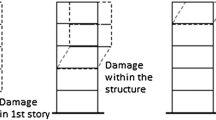Abstract
Recently the authors presented a single-agent Centralized Replicator Controller (CRC) and a decentralized Multi-Agent Replicator Controller (MARC) for vibration control of high-rise building structures. It was shown that the use of agents and a decentralized approach enhances the vibration control system. Two key parameters in the proposed control methodologies using replicator dynamics are the total population (total available resources or the sum of actuators forces) and the growth rate. In the previous research, a sensitivity analysis was performed to determine the appropriate values for the population size and growth rate. In this paper, the aforementioned control methodologies are integrated with a multi-objective optimization algorithm in order to find Pareto optimal values for growth rates with the goal of achieving maximum structural performance with minimum energy consumption. A modified neural dynamic model of Adeli and Park is used in this research to solve the many-objective optimization problem where the Normal Boundary Intersection method is employed to find Pareto optimality. Sample results are presented using a 20-story steel benchmark structure subjected to historical and artificial accelerograms.














Similar content being viewed by others
References
Adeli H, Jiang X (2009) Intelligent infrastructure – neural networks, wavelets, and chaos theory for intelligent transportation systems and smart structures. CRC Press, Taylor & Francis, Boca Raton
Adeli H, Kim H (2004) Wavelet-hybrid feedback least mean square algorithm for robust control of structures. J Struct Eng 130(1):128–137
Adeli H, Kim H (2009) Wavelet-based vibration control of smart buildings and bridges. CRC Press, Taylor & Francis, Boca Raton
Adeli H, Park HS (1995) Optimization of space structures by neural dynamics. Neural Netw 8(5):769–781
Adeli H,Park HS (1998) Neurocomputing for Design Automation. CRC Press
Adeli H, Saleh A (1997) Optimal control of adaptive/smart bridge structures. J Struct Eng 123(2):218–226
Adeli H, Saleh A (1999) Control, optimization, and smart structures - high-performance bridges and buildings of the future. John Wiley and Sons, New York
Adeli H, Gere J, Weaver W Jr (1978) Algorithms for nonlinear structural dynamics. J Struct Div ASCE 104(ST2):263–280
Aldwaik M, Adeli H (2014) Advances in optimization of Highrise building structures. Struct Multidiscip Optim 50(6):899–919
Aldwaik M, Adeli H (2016) Cost optimization of reinforced concrete flat slabs of arbitrary configuration in irregular highrise building structures. Struct Multidiscip Optim 54(1):151–164
Amezquita-Sanchez JP, Park HS, Adeli H (2017) A novel methodology for modal parameters identification of large smart structures using MUSIC, empirical wavelet transform, and Hilbert transform. Eng Struct 147:148–159
Amin M, Ang AH-S (1968) Nonstationary stochastic models of earthquake motions. Journal of the Earthquake Mechanics Division 94(2):559–584
Andersson A, O’Connor AJ, Karoumi R (2015) Passive and adaptive damping systems for vibration mitigation and increased fatigue service life of a tied arch railway bridge. Comput Aided Civ Inf Eng 30(9):748–757
Bakule L, Reha’k B, Pap’ık M (2016) Decentralized networked control of building structures. Comput Aided Civ Inf Eng 31(11):871–886
Bertsekas DP (2008) Nonlinear programming. Athena Scientific, Belmont
Cha YJ, Buyukozturk O (2015) Structural damage detection using modal strain energy and hybrid multi-objective optimization. Comput Aided Civ Inf Eng 30(5):347–358
Costa DMD, Paula TI, Silva PAP, Paiva AP (2016) Normal boundary intersection method based on principal components and Taguchi’s signal-to-noise ratio applied to the multiobjective optimization of 12L14 free machining steel turning process. Int J Adv Manuf Technol 87(1):825–834
Das I, Dennis J (1998) Normal-boundary intersection: a new method for generating Pareto optimal points in multicriteria optimization problems. SIAM J Optim 8(3):631–657
Der Kiureghian A, Neuenhofer A (1992) Response spectrum method for multi-support seismic excitations. Earthq Eng Struct Dyn 21:713–740
El-Khoury O, Adeli H (2013) Recent advances on vibration control of structures under dynamic loading. Arch Comput Meth Eng 20(4):353–360
FEMA (2012) P-58-1 Seismic performance assessment of buildings – volume 1 methodology. Federal Emergency Management Agency
Gutierrez Soto M, Adeli H (2017a) Recent advances in control algorithms for smart structures and machines. expert systems. 34:2, April 2017 (14 pages) (e12205)
Gutierrez Soto M, Adeli H (2017b) Multi-agent replicator controller for sustainable vibration control of smart structures. Journal of Vibroengineering 19(6):2017
Heloulou I, Said Radjef M, Tahar Kechadi M (2017) Automatic multi-objective clustering based on game theory. Expert Syst Appl 67:32–48
Jiang S, Yang S (2017) Evolutionary dynamic multi-objective optimization: benchmarks and algorithm comparisons. IEEE Transactions on Cybernetics 47(1):198–211
Kanai K (1957) Semi-empirical formula for the seismic characteristics of the ground. Bulletin of Earthquake Research Institute, University of Tokyo 35:309-325
Karami K, Akbarabadi S (2016) Developing a smart structure using integrated subspace-based damage detection and semi-active control. Comput Aided Civ Inf Eng 31(11):887–902
Kim H, Adeli H (2004) Hybrid feedback-least mean square algorithm for structural control. J Struct Eng 130(1):120–127
Lee HG, Yi CY, Lee DE, Arditi D (2015) An advanced stochastic time-cost tradeoff analysis based on a CPM-guided multi-objective genetic algorithm. Comput Aided Civ Inf Eng 30(10):824–842
Lin Y, Descamps P, Gaud N, Hilaire V, Koukam A (2015) Multi-Agent System for Intelligent Scrum Project Management. Integrated Computer-Aided Engineering 22(3):281–296
Lynch JP, Law KH (2002) Market-based control of linear structural systems. Earthq Eng Struct Dyn 31(10):1855–1877
Martinez-alvarez A, Crespo Cano R, Diaz-Tahoces A, Cuenca-Asensi S, Ferrandez Vicente JM, Fernandez Jover E (2016) Automatic tuning of a retina model for a Cortico visual Neuroprosthesis using a multi-objective optimization genetic algorithm. Int J Neural Syst 26:7 (15 template pages)
Morais H, Sousa TM, Santos G, Pinto T, Praça I, Vale Z (2015) Coalition of distributed generation units to virtual power players – a game theory approach. Integrated Computer-Aided Engineering 22(3):297–309
Pareto V (1906) Manuale di Economia Politica. Societa Editrice Libraria, Milano, Italy. Translated into English by A. S. Schwier as Manual of Political Economy, Macmillan, New York, 1971
Park K, Oh BK, Park HS (2015) GA-based multi-objective optimization algorithm for retrofit design on a multi- core PC cluster. Comput Aided Civ Inf Eng 30(12):965–980
Spencer BF, Christenson RE, Dyke SJ (1999) Next generation benchmark control problem for seismically excited buildings. Proceedings of the Second World Conference on Structural Control 2:1135–1360
Tajimi H (1960) A statistical method for determining the maximum response of a building structure during an earthquake. Proceedings of the Second World Conference on Earthquake Engineering, Tokyo and Kyoto, p 781-797
Turskis Z, Daniūnas A, Zavadskas EK, Medzvieckas J (2016) Multi-criteria evaluation of building foundation alternatives. Comput Aided Civ Inf Eng 31(9):717–729
Wang L, Wang X, Li X (2016) System method for dynamic loads identification via noisy measured dynamic responses. Eng Comput 32(4):1070–1094
Yang Z, Emmerich M, Baeck T, Kok J (2016) Multiobjective inventory routing with uncertain demand using population-based metaheuristics. Integrated Computer-Aided Engineering 23(3):205–220
Yeganeh-Fallah A, Taghikhany T (2016) A modified sliding mode fault tolerant control for large scale civil infrastructures. Comput Aided Civ Inf Eng 31(7):550–561
Zhu Z, Xiao J, Li JQ, Wang F, Zhang Q (2015) Global path planning of wheeled robots using multi-objective memetic algorithms. Integrated Computer-Aided Engineering 22(4):387–404
Author information
Authors and Affiliations
Corresponding author
Appendix
Appendix
The performance criteria used in this research to compare control algorithms is the following:
J 1 represent the maximum displacement corresponding to the horizontal displacement u i (t), u max is the maximum uncontrolled displacement.
J 2 denotes the maximum inter-story displacement or drift, h i is the height of each floor stories (h 1 = 5.49m; h i = 3.96m for i=1,...,20) and d max is the maximum uncontrolled drift.
J 3 denotes the maximum relative floor acceleration and \( {\ddot{u}}^{max} \) is the maximum uncontrolled absolute floor acceleration
J 4 denotes the maximum base shear, \( {V}_b^{max} \) is the maximum base shear for the uncontrolled case and m i is the seismic mass of floor i.
The following are the root-mean-squared (RMS) measurements criteria:
where J 5 is the normalized maximum RMS displacement of the controlled structure, \( \left\Vert {u}_j(t)\right\Vert =\sqrt{\int_0^{t_{\mathrm{end}}}\left[{u}_j^2(t)\right]\mathrm{dt}} \) divided by the maximum uncontrolled RMS displacement, \( {\widehat{u}}^{max} \).
J 6 is the normalized maximum RMS inter-story displacement or drift, and \( {\widehat{d}}^{max}=\mathit{\max}\left\Vert {d}_i(t)\right\Vert \) is the maximum uncontrolled RMS drift.
where J 7 is the normalized maximum RMS absolute floor acceleration of the controlled structure, \( \left\Vert {\ddot{u}}_j(t)\right\Vert =\sqrt{\int_0^{t_{\mathrm{end}}}\left[{\ddot{u}}_i^2(t)\right]\mathrm{dt}} \) divided by the maximum uncontrolled RMS absolute floor acceleration, \( {\widehat{\ddot{u}}}^{max} \). J 8 is the number of control devices and J 9 is the number of sensors.
Rights and permissions
About this article
Cite this article
Gutierrez Soto, M., Adeli, H. Many-objective control optimization of high-rise building structures using replicator dynamics and neural dynamics model. Struct Multidisc Optim 56, 1521–1537 (2017). https://doi.org/10.1007/s00158-017-1835-9
Received:
Revised:
Accepted:
Published:
Issue Date:
DOI: https://doi.org/10.1007/s00158-017-1835-9




